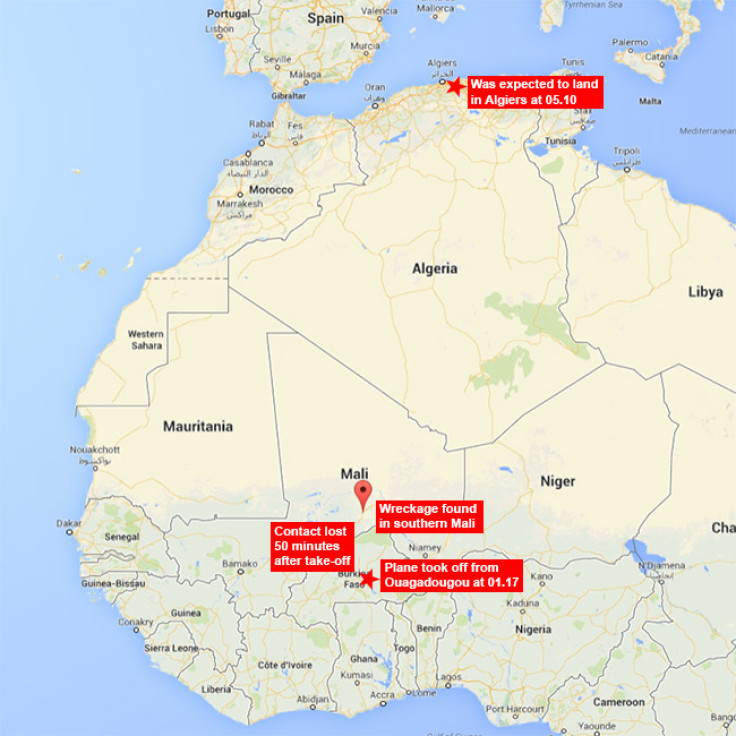Air Algérie Flight 5017: No Survivors of Crashed Plane Found

There appeared to be no survivors of the crashed Air Algérie Flight 5017 whose wreckage was found in northern Mali, 31 miles from the border with Burkina Faso.
The plane, an MD-83, carrying 110 passengers and a crew of six took off at 1:17am local time on Thursday from Ouagadougou, the capital of Burkina Faso, on a flight to Algiers.
Air traffic controllers lost contact with the plane less than an hour later, after it had passed northward out of the country's air space.
Burkina Faso Transport Minister Jean Bertin Ouedraogo told reporters that the pilots contacted air traffic controllers in Niamey, Niger, at 1:47am local time, and informed them that the plane was changing direction after encountering storms.
Flight 5017's usual northward route to Algiers would have taken it over desert areas where the militant groups have been active. But French military officials in the region said it was highly unlikely that the Air Algérie flight had been shot down.

Early theories about the cause of the crash have focused on the weather.
Fifty-one of the passengers on the plane were French citizens, and when it was reported missing, French warplanes based in the region were dispatched to hunt for it.
The jetliner belonged to a Spanish company, Swiftair, and was operated by Air Algérie.
Apart from the French citizens, the passengers included 28 people from Burkina Faso, eight Lebanese, six Algerians, five Canadians, four Germans, two people from Luxembourg, and one each from Switzerland, Belgium, Egypt, Ukraine, Nigeria, Cameroon and Mali, the Burkina authorities said.
Lebanese officials gave a higher figure, 10, for their citizens on the plane, and the Spanish pilots' union said all six crew members were Spanish, news agencies reported.
Eyewitness reports
Shepherds near the Malian desert town of Gossi told local officials that they had witnessed the crash from a distance. "The shepherds saw the plane fall," Louis Berthaud, the deputy mayor of Gossi, said.
Mohammed El Moctar, a Malian living in Burkina Faso, said he had spoken on phone to a cousin who is a shepherd in the Gossi area. His cousin saw the plane descending to a low altitude, following which he heard a loud rumbling and saw lots of smoke.
Fierce thunderstorms were pounding the Sahara region where the plane would have flown. The storms probably played a role in bringing the plane down, according to the official, Gen Gilbert Diendéré, chief of the general staff, a close aide to Burkina Faso President Blaise Compaore and head of the crisis committee set up to investigate the crash.
Residents of northern Mali reported a heavy sandstorm overnight. "There was a lot of damage from the wind, especially in the region of Kidal," said Kata Data Alhousseini Maiga, an official with the United Nations mission in Gao, Mali. "The sand was so thick that you couldn't see."
However, AccuWeather meteorologist Anthony Sagliani said the thunderstorms were not particularly violent.
"In general, there were scattered showers and thunderstorms across all of Burkina Faso and the southern half of Mali," Sagliani said. "This was with the monsoon trough, which is typically found here in late July. So this activity was quite normal."
General Diendéré said his men found the plane's wreckage in an isolated area about 60 miles south of the town of Gao in Mali. He said the troops had had to halt their examination for the night.
"They found human remains and the wreckage of the plane totally burnt and scattered," he said.
Algerian Transport Minister Omar Ghoul, whose country's planes were also searching for wreckage, described it as a "serious and delicate affair".
The vast deserts and mountains of northern Mali fell under control of ethnic Tuareg separatists and then al-Qaida-linked Islamic extremists after a military coup in 2012.
Air Algérie's last major accident was in 2003, when Flight 6289, a Boeing 737, crashed shortly after take-off from Tamanrasset in southern Algeria on its way to Algiers. Mechanical failure was blamed for the crash, which killed 102 people.
© Copyright IBTimes 2024. All rights reserved.





